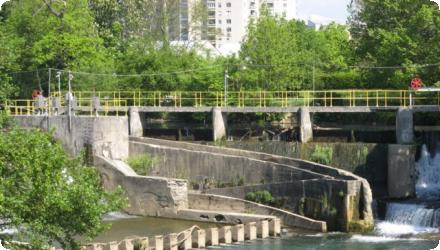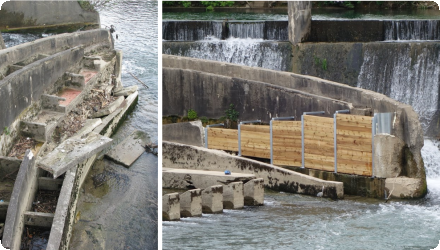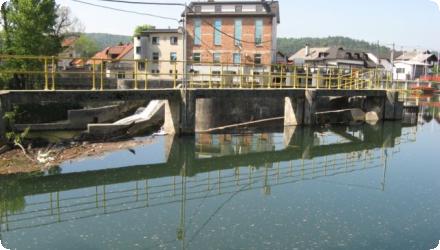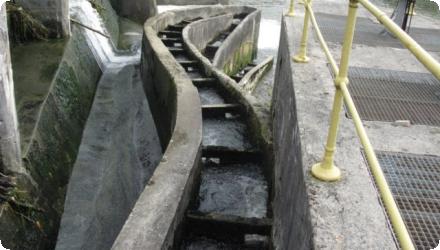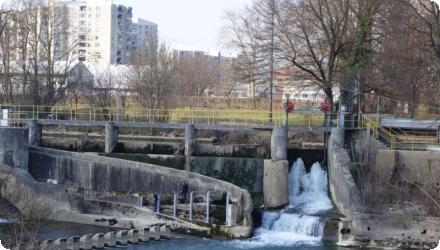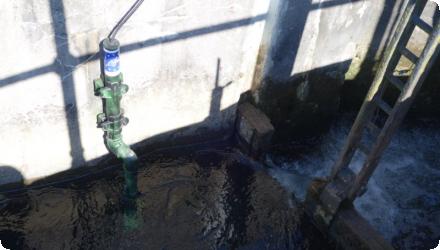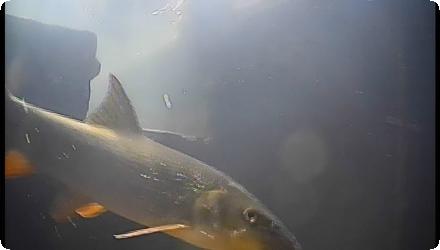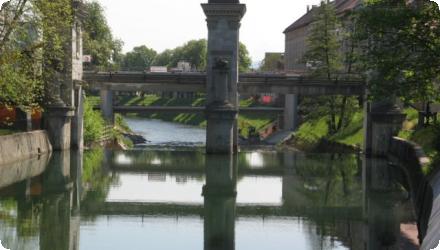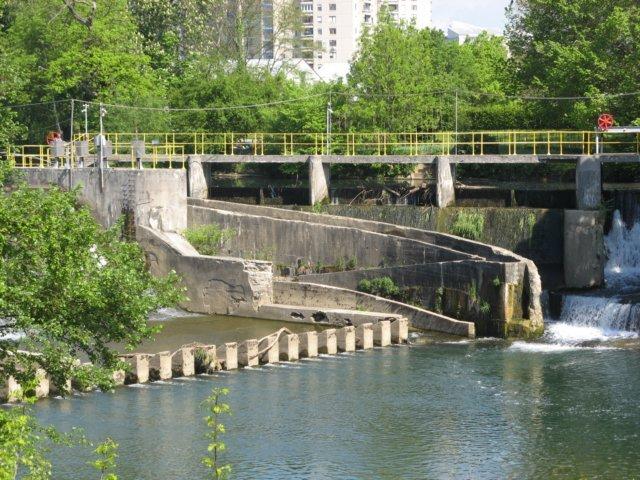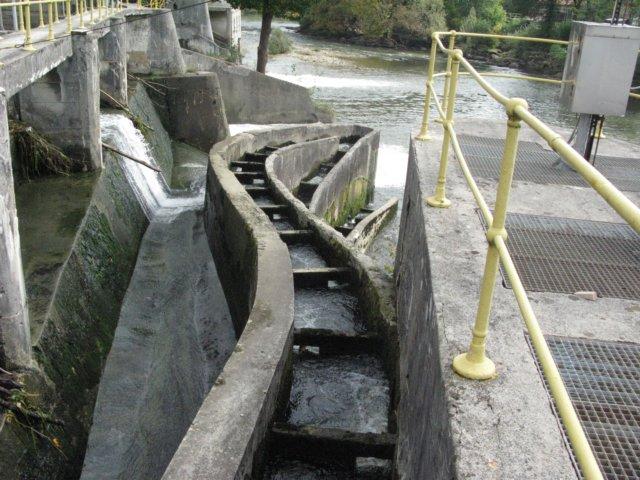Last update
2025
Summary
Removing barriers to fish migration, enhancing and restoring habitats, improving water-management infrastructure, and establishing a monitoring system. Funded by LIFE+ and implemented by Purgator Engineering Ltd. under the responsibility of the University of Ljubljana (UL FGG), the 2012–2016 “Ljubljanica connects” project rebuilt two dysfunctional fish passes (Fužine weir and Ambrožev trg), modernised the lifting gates at Ambrožev trg, and raised the Zalog sill by 20 cm to improve levels and oxygenation in upstream oxbows. A low-cost IR “fishcam” system was installed in both passes, providing continuous, online monitoring and confirming passage of 12 fish species, including the target Hucho hucho, Rutilus pigus and Leuciscus souffia. An After-LIFE plan maintains monitoring and knowledge transfer. While urban-section connectivity improved, full longitudinal continuity to the Sava remains constrained: the paper-mill weir at Vevče is the first impassable barrier upstream from the confluence, and the Gruber Canal sluice lacks a fish pass; national planning documents list measures to establish passability at Gruber. Coordinator: University of Ljubljana; partners: Purgator and Geateh.
Position
Latitude
46.047
Longitude
14.575
Project
NWRM
National Id
Slovenia_06
Installation date
2015-12
Implementation Status
Contact
REC
RBD code
SI_RBD_1
Transboundary
0
Photo gallery
Location of the project
This project is located on the Ljubljanica river, in Ljubljana.
NUTS Code
SI02 - Zahodna Slovenija
Project's objectives
Restore the Ljubljanica River’s corridor function to improve Natura 2000 coherence, specifically linking Ljubljansko barje (SI3000271) with Sava–Medvode–Kresnice (SI3000262).
Enable fish migration of 3 target species: Danube salmon (Hucho hucho), Danube roach (Rutilus pigus), and striped chub (Leuciscus souffia).
Remove/mitigate barriers to fish movement and improve water-management infrastructure along the urban reach.
Carry out an eco-hydrological survey and develop hydrological/hydraulic models as the basis for a management plan; identify threats and implement river restoration and habitat conservation actions to support WFD objectives.
Establish monitoring systems for fish passage and river conditions (video/IR “fishcam” and eco-hydrological logging envisaged in the project design).
Enable fish migration of 3 target species: Danube salmon (Hucho hucho), Danube roach (Rutilus pigus), and striped chub (Leuciscus souffia).
Remove/mitigate barriers to fish movement and improve water-management infrastructure along the urban reach.
Carry out an eco-hydrological survey and develop hydrological/hydraulic models as the basis for a management plan; identify threats and implement river restoration and habitat conservation actions to support WFD objectives.
Establish monitoring systems for fish passage and river conditions (video/IR “fishcam” and eco-hydrological logging envisaged in the project design).
Involved Partners
| Authority type | Authority name | Role | Comments |
|---|---|---|---|
Climate zone
cool temperate moist
Temperature
12
Precipitation
1339
Annual rainfall range
1200 - 1500 mm
Elevation range
277
Vegetation class
In-channel (project reaches): Aquatic macrophytes dominate (e.g., Sparganium emersum, Callitriche spp.; invasive Elodea canadensis documented along the Ljubljanica).
Wider floodplain upstream (Ljubljana Marsh / Natura 2000): Wet grasslands/meadows with hedges, shrubs and waterways are the characteristic matrix.
Wider floodplain upstream (Ljubljana Marsh / Natura 2000): Wet grasslands/meadows with hedges, shrubs and waterways are the characteristic matrix.
Water bodies: Ecological Status
Good
Water bodies: Chemical Status
Failing to achieve good
Water quality status
Hydromorphological alterations, faecal indicator bacteria downstream of the CČN outfall as the plant discharges to the Ljubljanica just before the Sava confluence.
Project scale
Micro
Project scale specification
Localised hydromorphological interventions at specific structures within Ljubljana: reconstruction of two fish passes (Ambrožev trg sluice and Fužine weir), modernisation of the Ambrožev trg lifting system, and raising the Zalog sill to improve upstream oxbows - i.e., site-specific works along a short urban reach rather than basin-wide actions.
Total cost
€ 1,168,765
Costs total information
Total eligible budget: €1,168,765.
EU (LIFE) contribution: €584,382.
EU (LIFE) contribution: €584,382.
Financing authorities
Type of funding
EU-funds: LIFE+
Comments
€ 584,382
Type of funding
National funds
Type of funding
Sub-national funds
Comments
Project coordinator
Type of funding
Private funds
Comments
0.111
Compensations
0
Policy context
Heavy degradation of the ecological functioning of the Ljubljanica River corridor “upstream and downstream of the Ljubljana urban area“ towards the confluence with the Sava, and further upstream along the Sava.
Land ownership
Publicly owned by the Republic of Slovenia
Community involvment
No
Design consultation activity
| Activity stage | Name | Key issues | Comments |
|---|
Policy target
| Target purpose |
|---|
|
Improved Biodiversity
|
Policy pressure
| Pressure directive | Relevant pressure |
|---|
Policy impact
| Impact directive | Relevant impact |
|---|
Requirement directive
| Requirement directive | Specification |
|---|
Contractual arrangements
0
| Arrangement type | Responsibility | Role | Name | Comments |
|---|
Part of wider plan
0
Wider plan type
| Wider plan type | Wider plan focus | Name | Comments |
|---|
Continue year-round fish-pass video monitoring (IR, image archiving/analysis for species and size) and continuous logging of water level and temperature at established stations.
Monitoring covers two strands. (1) Biotic passage at the Ambrožev trg and Fužine fish passes via IR-capable video; footage is analyzed to identify species, count individuals, and estimate fish length, with >200,000 images archived by the beneficiary; 12 fish species were confirmed moving through the passes during/after the project. (2) Eco-hydrological context via continuous water-level and water-temperature loggers at multiple sites (~17) along the corridor to inform models and management. Supplementary evaluation included VIE tagging reported in conference materials.
Maintenance
The UL FGG keeps the fish-pass camera system and website in operation in line with the project’s After-LIFE plan; no separate municipal O&M scheme is documented in the sources.
Recreation & angling. The local anglers’ society gained members thanks to strengthened fish populations (notably Danube salmon). Other recreational activities along the river are expected to increase.
Adding debris-deflectors at fish-pass exits reduced ingress of floating material and thereby reduced damage and maintenance costs for the structures.
Risk management co-benefit. Modernised lifting gates at Ambrožev trg allow precise level control, highlighted as important for flood protection and climate-change adaptation.
Adding debris-deflectors at fish-pass exits reduced ingress of floating material and thereby reduced damage and maintenance costs for the structures.
Risk management co-benefit. Modernised lifting gates at Ambrožev trg allow precise level control, highlighted as important for flood protection and climate-change adaptation.
Information on retained water
Precise water-level regulation, cited as important for flood protection and climate-change adaptation.
At Zalog, the sill was raised by 20 cm, which increased upstream oxbow water levels.
At Zalog, the sill was raised by 20 cm, which increased upstream oxbow water levels.
Water quality overall improvements
Positive impact-WQ improvement
Information on Water quality overall improvements
Increase in river water quality, especially via slowed heating and higher dissolved oxygen in the oxbows after the Zalog action.
1
Two fish passes reconstructed (Fužine, Ambrožev trg). Monitoring confirmed passage of 12 fish species, including the three targets (Hucho hucho, Rutilus pigus, Leuciscus souffia). >200,000 photos archived; ~20% used for species determination.
However the Vevče paper-mill weir remains the first impassable barrier from the Sava into the Ljubljanica, interrupting full longitudinal continuity.
However the Vevče paper-mill weir remains the first impassable barrier from the Sava into the Ljubljanica, interrupting full longitudinal continuity.
Key lessons
Targeted, small-scale works at key urban barriers can reopen passage and measurably improve local conditions when paired with monitoring. In Ljubljana, rebuilding the Ambrožev trg and Fužine fish passes and raising the Zalog sill (+20 cm) restored movement at those sites and improved oxbow water quality by increasing water level, slowing heating, and raising dissolved oxygen. Continuous, low-cost IR video monitoring confirmed use by 12 fish species and created an engaging, public data stream. Modernising the Ambrožev trg lifting system also delivered precise level control valued for flood protection and climate-adaptation operations.
However, site-level fixes alone did not achieve full longitudinal continuity. The Vevče paper-mill weir remains the first impassable barrier from the Sava into the Ljubljanica, as shown by tagged Hucho hucho movements; functionality at the Fužine pass was also intermittently interrupted during the project, underscoring the importance of downstream bottlenecks and O&M reliability for corridor-scale outcomes.
However, site-level fixes alone did not achieve full longitudinal continuity. The Vevče paper-mill weir remains the first impassable barrier from the Sava into the Ljubljanica, as shown by tagged Hucho hucho movements; functionality at the Fužine pass was also intermittently interrupted during the project, underscoring the importance of downstream bottlenecks and O&M reliability for corridor-scale outcomes.
Success factor(s)
| Success factor type | Success factor role | Comments | Order |
|---|---|---|---|
|
Other
|
main factor
|
Clear, focused scope on two dysfunctional fish passes plus the Zalog sill (doable, high-leverage fixes). |
|
|
Available support tools
|
secondary factor
|
Innovative IR “fish-cam” system providing continuous evidence and public outreach at low cost. |
|
|
Successful coordination between authorities
|
secondary factor
|
Effective partnership led by UL-FGG with Purgator and Geateh |
Driver
| Driver type | Driver role | Comments | Order |
|---|
Transferability
Highly transferable to urban rivers with legacy barriers: rebuilding fish passes, modest sill tweaks and gate modernisation can restore local passage and improve level control, especially when paired with low-cost fish-cam and eco-hydrological monitoring. But scrutinise corridor bottlenecks (e.g. downstream impassable weirs/sluices), species-specific design and O&M (debris, outages), and secure capacity for long-term monitoring.
Cost effectiveness
The "fish cam" device to monitor the effectiveness of the fish pass is considered as a cost effective technology.
English
